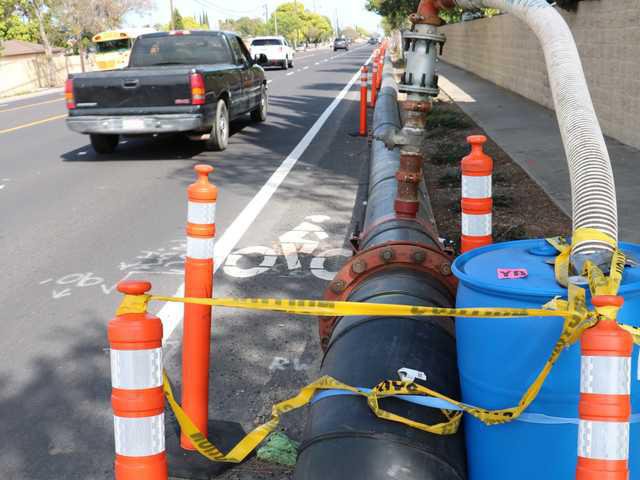The 200-year flood protection mandate did more than just force Manteca and Lathrop to work together towards a regional solution costing upwards of $170 million to protect 48,000 existing residents whose safety would be jeopardized if such an event overwhelmed existing levees.
It is also making both cities take a serious look at partnering to make sure their citizens can continue flushing their toilets without running afoul of other state laws.
By establishing a mandate requiring protection against a 200-year event — a flooding occurrence that has a 1 in 200 chance of happening in any given year and not at a frequency of once every two centuries — it essentially wiped out the ability for Lathrop to develop a 2,000-acre area for spray fields for land disposal of treated wastewater from their current wastewater treatment plant and future expansions.
When Lathrop indicated to the Central Valley Regional Water Quality Control Board that it wanted to pursue plans to discharge treated water to the river which requires the agency to issue a permit, the response was clear: The best chances to move forward would be for Lathrop to work out a deal to send its wastewater to Manteca for discharge after it is treated and/or for treatment so the existing outfall to the San Joaquin River from the Manteca plant can be used.
Regional Water Quality Control Board Executive Officer Patrick Pulupa presented his agency’s “viewpoint” on a possible Manteca/Lathrop Regionalization during a Manteca City Council meeting last week.
The bottom line: Given serious concerns with Delta water quality the regional water board frowns upon approving additional discharge permits to the San Joaquin River with the added caveat that any proposed Lathrop outfall for treated water to the river would be too close to Manteca’s that the chances of it being approved are even slimmer. The concerns are based on the need for mixing zones — where treated water assimilates into river water — to be spaced far enough apart that they will work effectively. And if the water board were to grant a permit for Lathrop to discharge into the river it would have ramifications on Manteca’s ability to discharge treated wastewater from its position farther upstream.
Manteca Public Works Director Mark Houghton told the council there have already been staff level discussions with Lathrop to explore regionalization options.
Since the 1980s, Lathrop has paid for the allocation of 14.7 percent of the Manteca treatment plant capacity. The plant is located on West Yosemite Avenue just north of the Big League Dreams sports complex. In recent years Lathrop has built its own treatment plant while continuing to send wastewater to Manteca. The loss of the option of employing 2,000 acres for land disposal means Lathrop’s ability to expand their plant to handle growth would be jeopardized unless they were able to discharge to the river.
Numerous concerns
Pulupa outlined the issues the water board has to address whenever they issue a permit.
Delta concerns include:
Impairments such as salinity, toxicity, mercury, pesticides, and dissolved oxygen.
Nutrients including harmful algal blooms and water supply impacts.
Declining fisheries involving endangered species such as the Delta smelt and Chinook salmon as well as pelagic organism decline.
Concerns for proposed discharge to the San Joaquin River include:
Critical habitat for threatened and endangered species.
That includes temperature and toxicity impacts to the Delta smelt, salmon and steelhead. A permit request would trigger studies by fishery agencies. It would also impair the Delta ecosystem with nutrients. It also impacts pelagic organism decline.
Lathrop is near the state and federal export pumps for the California Aqueduct as well as the Delta-Mendota Canal.
Increased salt loading — treated wastewater is heavily laden with salts —has an adverse impact on crops unless adequate dilution is available. Increased nutrient loading impacts water supplies and algal blooms can result in the need for increased treatment and cause taste and odor issues.
It’s close proximity to Manteca’s discharge point to the river.
Two outfalls to the river as close as Manteca’s would be to the proposed Lathrop discharge point would reduce assimilative capacity for downstream dischargers. Mixing zones may be difficult when close or overlapping other outfalls.
Before new permits such as the one Lathrop is requesting for river charges can be considered for approval the applicant must exhaust other alternatives such as expanded land disposal that the 200-year flood plain designation has taken off the table as well as reclamation, conservation, and regionalization.
There is also ever increasing stringent requirements placed on river discharge for toxicity, salinity, pesticides, and mercury.
Pulupa noted the sharing of responsibility for providing wastewater services would allow some economies of scale including consolidated services for billing, certified operators, and other administrative functions.
Examples of regionalization include:
Shared treatment capacity and outfall.
Shared unit operations and outfall.
Satellite treatment facilities with combined outfall/discharge point.
easons Pulupa gave for regionalization include:
Fewer discharge points leading to decreased environmental impacts on the Delta.
Better testament performance.
Better water quality.
Better consistency in meeting water quality standards.
More efficient energy use.
Lower per-gallon treatment costs.
More effective way to plan for future growth.
More state funding available.
Fewer permits, reduced costs of compliance.
Limits liability from Clean Water Act lawsuits and mandatory minimum penalties.
To contact Dennis Wyatt, email dwyatt@mantecabulletin.com
FLUSHING AS ONE
Manteca, Lathrop may join forces



